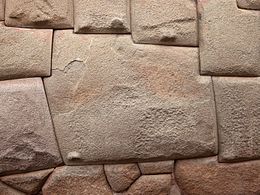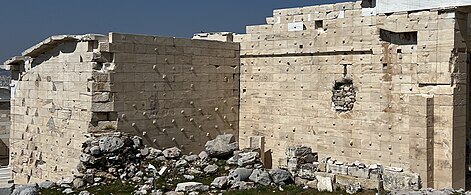Lifting boss
Appearance
Lifting bosses or handling bosses are protrusions intentionally left on stones by masons to facilitate maneuvering the blocks with ropes and levers.[1][2]
They are an important feature of ancient and classical construction, and were often not cut away, despite having fulfilled their purpose. Sometimes this was the result of a cost-saving measure or a construction halt. Other times bosses were left as a stylistic element, and even if dressed back, a remnant of them was kept to make their existence obvious.[3]
-
Levering bosses left on Inca walls of Cusco, Peru
-
Bosses on the Propylaia (Acropolis of Athens)
See also
[edit]Wikimedia Commons has media related to Lifting bosses.
References
[edit]- ^ Arnold, Dieter (1991). "Bosses". Building in Egypt: Pharaonic Stone Masonry. pp. 132–141. ISBN 9780195113747.
- ^ Stocks, Denys A. (2003). Experiments in Egyptian archaeology - Stoneworking technology in Ancient Egypt. p. 193.
- ^ Devolder, Maud; Kreimerman, Igor (2020). Ashlar: Exploring the Materiality of Cut-Stone Masonry in the Eastern Mediterranean Bronze Age. p. 313. ISBN 9782875589644.
Further reading
[edit]- Clarke, Somers; Engelbach, R. (1990). "Handling the Blocks". Ancient Egyptian construction and architecture. pp. 84–95. ISBN 978-0-486-26485-1.
- Coulton, J. J. (1974). "Lifting in Early Greek Architecture" (PDF). The Journal of Hellenic Studies. 94: 1–19. doi:10.2307/630416. JSTOR 630416.
- Philokyprou, Maria (2011). "The initial appearance of ashlar stone in Cyprus. Issues of provenance and use" (PDF). Mediterranean Archaeology and Archaeometry. 2011 (2, pp): 44–45. Archived from the original (PDF) on 2018-04-09.
- Schreiber, Th (1895). Anderson, W. C. F. (ed.). Atlas of classical antiquities. London: Macmillan. pp. 18, Plate IX. doi:10.11588/diglit.49928.



